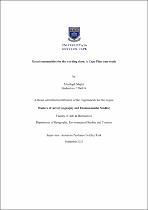| dc.description.abstract | Gated developments are proliferating across cities globally, in different forms and contexts. While they have emerged in cities in both the global North and South, the number of gated developments has increased recently in cities in the global South. Uniformly defined on the basis of their physical features, security artefacts and codes of conduct, gated developments have received criticism across a number of disciplines yet are seen as a rational response to increasing crime rates and considered as a safe haven for their residents. In the global South, more than simply safe havens, gated developments are typically perceived as islands of wealth and privilege in a sea of urban inequality. There is a pressing need to understand the gated development model in the context of the global South. In South Africa, the increase in gated developments situated in lower income areas has been scarcely explored. It is on this basis that this study examines an underexplored and recent category of gated development in the South African context: Gated developments in low-income residential areas. | en_US |

